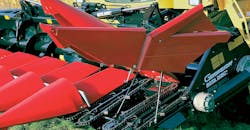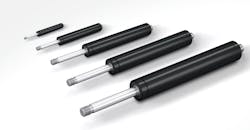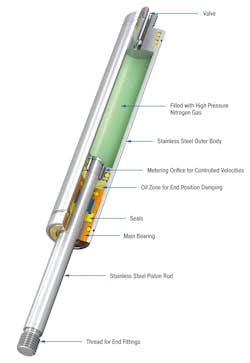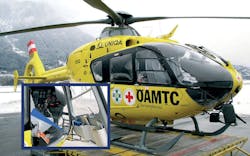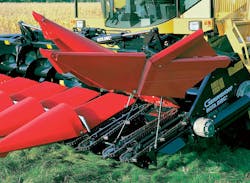A Guide to Gas Spring Design and Customization
When a design calls for an industrial gas spring, there’s a wide range of standard, off-the-shelf products available from various manufacturers. But ordering a gas spring from a catalog comes with a lot of risks. Depending on the application, it’s likely that some degree of customization is necessary to ensure just the right gas spring is found.
There is a better way to get the best gas spring: Take an engineering approach to adding gas springs to designs, and use standard industrial gas springs as a starting point.
Gas springs are self-contained, force generating, maintenance-free cylinders. They are used to move and position lids, chairs, table-tops, and host of other assemblies. body is pre-charged with nitrogen gas to provide a specific output force. Pressure is applied to the piston and diameter area, which provides the output force in push-type gas springs.
Standard Gas Springs
Standard gas springs are quick and easy to order. They’re also relatively inexpensive, provided they don’t need troubleshooting right out of the box to fit the application. However, customers may underestimate how much data they need to specify gas springs. Furthermore, off-the-shelf gas springs commonly offer only one of three choices of output force. Will one of them be exactly right? There’s a good chance designers and customers may get unintended results.
If factory-supplied output forces don’t work, hoods or lids may open unexpectedly, or the spring might not support the load it needs to move. Another concern with off-the-shelf gas springs: customer drawings fail to allow room in the installation for the spring. Or, the spring comes with the wrong end fittings. These situations often force customers to waste time trying different forces and modifying the assembly, and they still may not get the right gas spring for the job. All this trial-and-error inflates labor costs and the project suffers needless delays.
Unlike most standard gas springs, an engineered spring is, in essence, a custom part the manufacturer typically adjusts to an application’s specifications. The added investment usually pays off via saved time and labor costs that come from gas springs working perfectly the first time.
Gas Spring Basics
To understand the important factors to consider when ordering a custom gas spring, engineers should know the basics behind how they work.
Gas springs are self-contained, force generating, maintenance-free cylinders. The body is filled with pressurized nitrogen gas that generates a specific pressure. The pressure pushes on the piston, which provides the output force in push-type gas springs. As the piston rod is pushed and compressed, the piston generates a constant output force and controls its velocity by metering nitrogen through a hole. A little oil dampens, or cushions, piston movement at the end of travel when the gas spring is mounted with the piston rod facing downward. Some gas springs have a field-accessible vent valve for venting nitrogen to reduce the spring’s force.
Depending on the application, designers can choose from several types of gas springs. Some common gas spring types include:
Push-type to lift and lower loads with easy control and minimal exertion. Push-type gas springs support covers and lids in a broad range of industries.
Pull-type to fit in tight. This type is compact and mounts in any orientation and position. Unlike in standard push-type springs, pressure in the cylinder retracts the piston rod. Pull-types can have low progression rate. Progression is the increase in force exerted by the gas spring over the stroke. Progression rates, which measure the change in progression, can be as low as 11%.
They also can have an adjustment valve to control the traction force. Traction force is the pulling force from the gas pressure that retracts the rod. It can be as low as 11 lb and as high as 1,630 lb, depending on the gas spring. Providing this pulling force is the gas spring’s main function as it helps in lifting and holding up all types of heavy objects in many different applications.
Locking to hold a position. Chairs often need to maintain a certain position to support a patient or someone. In an adjustable desk chair, for example, a person adjusts the height by first pressing a button or lever. This opens a piston valve so the seat can be moved up or down to the desired position. Letting go of the button or lever lets the valve closes and locks the piston so the seat remains at that height.
Two custom-made stainless-steel locking gas springs from Ace Controls lets this hygiene and toileting device for children with disabilities be inclined up to 15 deg. forward or aft and be easy to clean.
Two custom-made stainless-steel locking gas springs from Ace Controls lets this hygiene and toileting device for children with disabilities be inclined up to 15 deg. forward or aft and be easy to clean.
To get the best performance from an off-the-shelf gas spring, it’s important to identify the following parameters as you begin the selection process. Sometimes mistakes happen here, but the right gas spring manufacturer can provide the tools and engineering support to help designers get started.
Size and weight: Know the dimensions and weight of the object being moved. For best results, use a spring scale to determine its weight.
Orientation: The body of the gas spring must fit within the assembly without anything limiting its range of motion.
Pivot point: The pivot point or hinge provide support and is the axis of rotation for hoods and covers and other rotating objects. Is it at the top, middle, or bottom?
Point of lifting: Where will users push or pull to move the load?
Starting angle: The angle of the load before the spring begins its travel.
Finishing angle: The angle of the load when the spring ends its travel.
Hand force: The amount of force users must apply to move the load. An application engineer can help determine the necessary hand force for different angles of movement throughout the load’s complete motion.
Extension force: Gas springs apply forces to counterbalance the load or hood being moved. Designers decide how much nitrogen goes inside the spring that pushes the piston head and gives it the force to move the load. Some manufacturers and suppliers have calculators that help customers balance the forces the gas spring needs to apply in relation to its load.
Center of gravity: Understanding how the geometry and weight of the load are all affected by gravity is critical when determining where to mount the gas spring, the force needed to counterbalance the load, and where to make the compromise. When gas springs are mounted with their center of gravity close to the pivot, their operation is easier to predict.
Stroke length: The distance the load must move. Make sure the gas spring can manage the overall force in the installation. Gas spring vendors have product data that show how different forces interact with stroke and how much force a specific stroke length can handle.
Mounting: How the gas spring is mounted determines the load’s opening angle and the distance the gas spring needs to move the load, which is commonly known as stroke. For example, linear applications have a straight stroke. You will need to know the load’s dimensions and account for any equipment or obstructions nearby that could affect the mounting location.
Materials: Most gas springs are used in benign indoor environments, so they are usually made of carbon steel. However, customers may opt for rust-inhibiting materials or UV coatings if they will be used near saltwater or in food and medical applications. Some vendors offer rust-inhibiting versions of standard models to protect against corrosion in food and hygienically sensitive areas like clean rooms. ACE Controls, for example, offers standard gas springs with an advanced UV coating or 303 or 316 VA stainless steel outer bodies that can be filled with food-grade oil, conforming to FDA 21 CFR 178.3570, which regulates incidental food contact.
Ambient temperature: This refers to the range of temperatures in the gas spring’s proposed operating environment.
Industrial gas springs from Ace Controls make it easy to open and close the doors on this rescue helicopter. The maintenance-free, sealed springs are installed on the access doors of EC 135 helicopters. They let the crew enter and exit the helicopter quickly, enhancing safety. The GS-19 gas springs provide a defined retraction speed and secure engagement of the door lock. The built-in end-position damper allows for gentle closing of the door which saves wear and tear on the lightweight material.
Mounting Gas Springs
When mounting a gas spring, make sure the spring fits within the device. The general tolerance for fitting a gas spring is ±0.08 in., but it varies depending on spring’s size and extension force. So check with the manufacturer to get the correct tolerance. If the application demands durability and stability, do not combine a small diameter body with a long stroke length and high forces in your gas spring.
Proper alignment is also crucial for preventing side loads that can damage a gas spring’s seal and piston rod. Consider end fittings with a swivel eyelet or angle ball joint, as these help mitigate minor sideloads. An application engineer can recommend the best mounting strategy and end fittings to alleviate side-load risks.
Finally, gas springs should be installed with the piston rod downwards. As a gas spring nears full extension and the piston rod reaches the bottom, it travels through a small oil chamber which provides end damping to soften the motion. The chamber helps keep the seal lubricated to extend the life of the gas spring, and it allows for alternative mounting configurations.
Sometimes, it’s necessary to modify gas springs to get smooth, even motion throughout the stroke. Often, changing to a different-size piston rod will increase or decrease the force resistance. For instance, adding a larger piston rod to a cylinder with a smaller body increases the progression value (the force difference between two different rod positions). Conversely, using a slightly smaller rod than offered in the standard size may lower it.
To change the extension speed, manufacturers fine-tune the orifice and piston head.
If the required stroke length is in between those provided by an off-the-shelf spring, the rod can be cut to the right length.
For gas springs that must operate in extreme temperatures, get the spring vendor to make springs from grades of steel that withstand harsh temperatures.
Gas springs prevent injuries during maintenance on harvesting machines such as this reaper. The blades of corn picking devices are arranged under plastic hoods. For maintenance, the 15-lb hoods must be lifted. To protect maintenance personnel from injury and keep hoods from falling, the hood is kept in the open position by GS-22 industrial gas springs. As an added advantage, gas springs offer added stability under rough operating conditions due to a wear-resistant coating on the piston rod and housing.
Protecting Gas Springs
Some gas springs operate in demanding applications and environments, so consider the following accessories to make the springs last:
To keep them clean, use rod wipers attached to the rod to keep it clean, as well as protect it from debris and caustic fluids.
When safety is a concern, locking tubes will prevent your lids, gates, and covers from closing accidentally. These devices lock in the spring’s extended position and eliminate the need for a support rod.
To make mounting easy and versatile, choose gas springs with interchangeable end fittings made of steel.
Selecting and installing off-the-shelf gas springs is often an inexact and time-consuming process. Although they may be a quick and inexpensive purchase, a lot can go wrong during sizing and, ultimately, implementation. That’s why it often pays to buys gas springs from manufacturers with a multifaceted, engineered approach that include online selections and implementation resources, along with application engineers who will work through the data requirements and provide the tools, adjustments, and accessories to match it perfectly. An engineered approach means you’ll only need to drill four holes, place the order, and install the springs. You’ll also have the right calculations for future re-orders, so you’ll always save time, effort, and money.
Dave Rowland is a product engineer at ACE Controls. If you have any questions about industrial gas springs, contact Ace at (248) 476-0213 or online.
